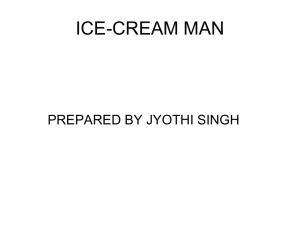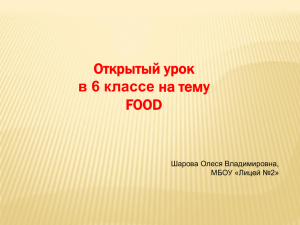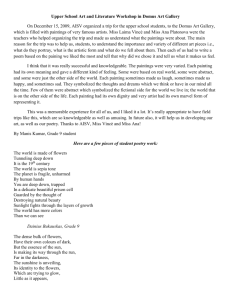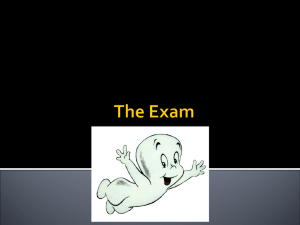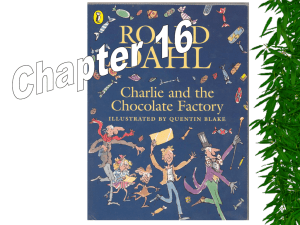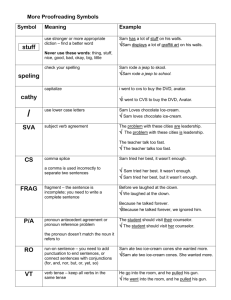We all scream for Icecream - L1 Cross curricular unit plan
advertisement
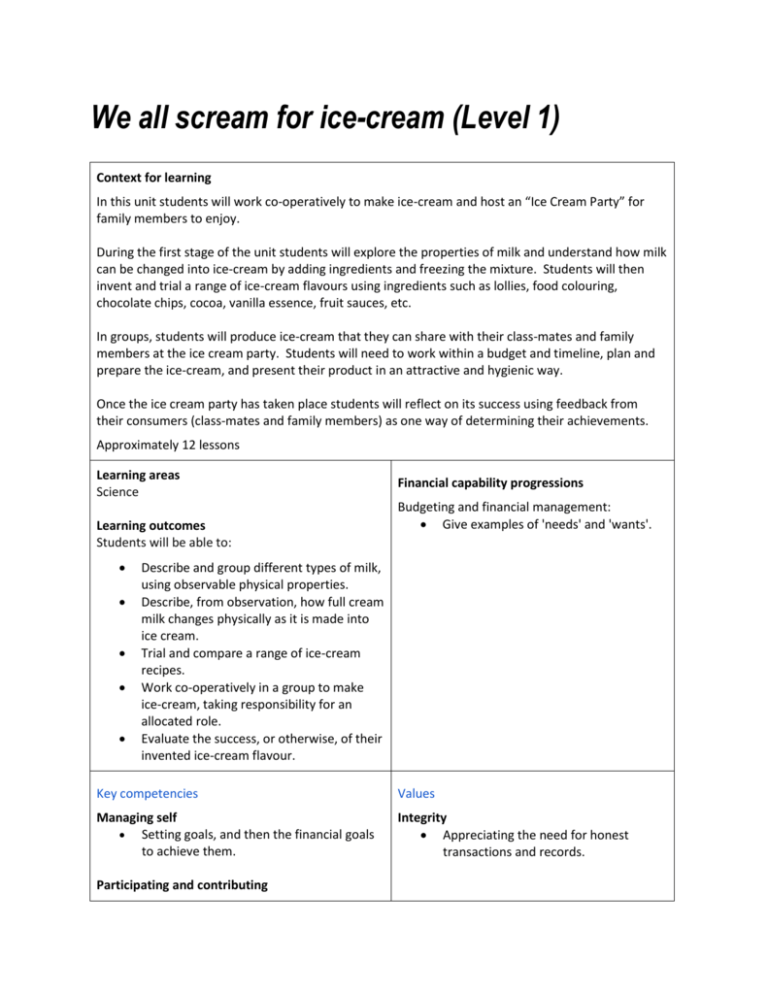
We all scream for ice-cream (Level 1) Context for learning In this unit students will work co-operatively to make ice-cream and host an “Ice Cream Party” for family members to enjoy. During the first stage of the unit students will explore the properties of milk and understand how milk can be changed into ice-cream by adding ingredients and freezing the mixture. Students will then invent and trial a range of ice-cream flavours using ingredients such as lollies, food colouring, chocolate chips, cocoa, vanilla essence, fruit sauces, etc. In groups, students will produce ice-cream that they can share with their class-mates and family members at the ice cream party. Students will need to work within a budget and timeline, plan and prepare the ice-cream, and present their product in an attractive and hygienic way. Once the ice cream party has taken place students will reflect on its success using feedback from their consumers (class-mates and family members) as one way of determining their achievements. Approximately 12 lessons Learning areas Science Learning outcomes Students will be able to: Financial capability progressions Budgeting and financial management: Give examples of 'needs' and 'wants'. Describe and group different types of milk, using observable physical properties. Describe, from observation, how full cream milk changes physically as it is made into ice cream. Trial and compare a range of ice-cream recipes. Work co-operatively in a group to make ice-cream, taking responsibility for an allocated role. Evaluate the success, or otherwise, of their invented ice-cream flavour. Key competencies Values Managing self Setting goals, and then the financial goals to achieve them. Integrity Appreciating the need for honest transactions and records. Participating and contributing Collaborating with others and in a team. Thinking Identifying and deciding on different financial options. Community Working collaboratively when making financial decisions and achieving goals. Excellence Setting financial goals and achieving them. Resource requirements School Journal texts: “Ice-Cream” (School Journal Pt 1, No 4, 1994) “Make Up Your Mind” (School Journal, Pt 2, No 1, 2005) Text: Making Better Sense of the Material World, Levels 1 - 4, Ministry of Education Local dairy or supermarket Freezer/s Ice-cream ingredients Equipment to prepare and present ice-cream eg: mixing bowls, ice-cream containers, plastic cups, etc Decision Making Grid Teaching and learning sequence NB: Teachers are encouraged to gauge the prior knowledge of their students before implementing each unit so that they can provide personalised and meaningful learning opportunities. The teaching and learning sequence provided in each unit is to be viewed as a guide only. Teachers will need to adapt this sequence to meet the needs of their students, school and community. The future focus issues of citizenship and enterprise can be explored during this unit. Students will need to be innovative and enterprising in deciding which ice-cream to make and how to make them. They will also need to enterprising to keep within their timeline and budget for their ice-cream party. The party will be enjoyed by people in their community, so students can be applauded for bringing pleasures to others, rather than just themselves. These are first steps in becoming good citizens. The numbered activities listed below are learning steps rather than lessons. Teachers may choose to combine two or three learning steps into one lesson. Alternatively, they may spread one learning step out over several lessons. This will be largely dependent on students’ prior knowledge and their subsequent learning needs. Getting started The teacher reads the journal story “Ice-Cream” (School Journal Pt 1, No 4, 1994) to the students. This story describes how a little girl talks her big sister into buying her an ice-cream but she can’t decide which flavour to have. The teacher asks the students: “what is your favourite ice-cream flavour?” The unit and focus for learning is described to the students. Explain that the class will: Explore the ice-cream making process and invent a variety of ice-cream flavours Work in co-operative groups to make ice-cream for an Ice Cream Party which family members can attend. The students then make invitations for their Ice Cream Party and distribute them to family members. The class creates a timeline for the unit with key dates for critical actions. This process will make the teaching sequence of the unit explicit to the students. Exploring 1. 2. The teacher and students complete a brainstorm to record students’ prior knowledge about milk and ice-cream. Prompt questions could include: Why do milk cartons have different coloured lids? Where does milk come from? Why does milk need to be kept in the fridge? What things can we make from milk? What else looks a little like milk, but is different? What is ice-cream made of? Why is ice-cream kept in the freezer? Etc. Students explore various types of milk (full-cream, trim milk, condensed milk, goat’s milk, flavoured milk, cream, etc) by studying the colour, taste and consistency. Pour about 150 millilitres of each type of milk into a clear container. Invite students to observe the appearance of the milk samples. Do some samples appear thicker than others? Do the samples pour quickly or slowly? Can you see any differences in colour? Use tasting cups and get students to taste each sample. Record all relevant comments and observations on a chart like the following one: (Learning Outcome 1) Type of Milk What colour is it? How does it look? How does it pour? How does it taste? Milk 1 Milk 2 Milk 3 Milk 4 3. 4. Re-visit the chart produced at step 2 and ask students to suggest reasons for why each type of milk is different. Explain to students that milk is made up of a range of substances (water, fats, proteins, milk sugars and minerals) and that milk can be altered by adding more of, removing part of or breaking down some of these substances it contains (eg: trim milk has reduced fats in it, cream is collected fat, etc) (LO 1) The teacher and students make ice-cream following the instructions listed below (courtesy of “Making Better Sense of the Material World: Levels 1-4”): Ingredients: 200 grams of salt, 120 millilitres of milk, 20 grams of sugar, vanilla essence, 2 clip lock plastic bags (1 large bag and 1 small bag), 1 kilogram of crushed ice, a 2 litre ice-cream container. Instructions: Half fill the large plastic bag with crushed ice. Add the salt. Put the large plastic bag into an ice-cream container. Put the milk, vanilla, and sugar into the small plastic bag. Seal the bag tightly. Place the small bag inside the large bag that contains the ice and salt mixture. Seal the larger bag. Shake and move the bags about until the mixture inside the small bag turns to ice-cream. This will take about 5 – 10 minutes. 5. Students draw what they saw happening inside the plastic bags when making the ice-cream. Encourage the students to understand that the milk has changed into ice-cream because it has been exposed to a colder temperature. Ask the students what might happen to the ice-cream if the ice is taken away. Use the words ‘liquid’ and ‘solid’ during these discussions. (Learning Outcome 2) Planning and creating 6. The teacher and students visit the local dairy or supermarket to find out what different flavours of ice-cream are available in shops. Compile a list of existing flavours and identify what ingredients have been added to each ice-cream flavour in the production process. Extension Idea: A senior buddy class could perform the play “Make Up Your Mind” (School Journal, Part 2, Number 1, 2005) to the class. This play features a range of ice-cream types and could be used to add further ice-cream flavours to the list. 7. The teacher and students explore the following question: What ingredients can be added to a vanilla ice-cream recipe to change the flavour? The students brainstorm ideas for their own ice-cream flavours. Possible ideas could include: orange essence and lemon jelly lollies; chocolate chips and marshmallows; red food colouring and green jellybeans, etc. (Learning Outcome 3) 8. The teacher and students make and taste several different ice-cream flavours using ideas generated from the brainstorm. The teacher may decide to use the vanilla ice-cream recipe offered at step 4 as a base or source their own recipe for vanilla ice-cream. The teacher and students then evaluate the success of each ice-cream flavour by using a decision-making grid template. Possible criteria for the evaluation could include: How does the ice-cream look? How does it taste? What did it cost to produce? How hard was it to produce? Etc. (LO 3 9. The teacher divides the class into small working groups (3 or 4 members) and challenges them to make their own ice-cream flavour. The teacher and students create a set of “success criteria” to measure their completed ice-cream flavours against. Possible criteria could include: the ice-cream looks appealing; the ice-cream tastes nice; the ice-cream ingredients did not cost too much; the ice-cream flavour was original, etc. 10. The students work together in their co-operative groups to plan and produce their ice-cream. NB: Lessons on co-operative work may be required if students are not used to working in groups. Students are given a set budget (approximately $6.00 per group) for purchasing the ice-cream ingredients (the teacher could supply the generic ingredients such as sugar, vanilla, etc). The students need to decide on their ice-cream flavour, develop a task list*, allocate responsibilities and produce a timeline for the ice-cream production. (Learning Outcome 4) *The task list could include the following jobs - listing the required ingredients, working out the cost of each ingredient, going shopping, collecting the equipment, writing or drawing the instructions, making the ice-cream, naming the ice-cream flavour, sharing the ice-cream at the Ice Cream Party, etc. 11. Students work co-operatively to produce their ice-cream. Parent helpers or older students could be invited to assist during the ice-cream production process. Good hygiene practices (eg: washing hands, using clean equipment, storing the ice-cream at the correct temperature, etc) will need to be adhered to. (LO 4) Sharing and evaluating 12. 13. 14. The teacher and students organise and host their Ice Cream Party. Students are given responsibilities such as classroom decorators, welcoming committee, hygiene officers, icecream scoopers, waiters and waitresses, spokespeople who explain the learning, etc. Students use the “success criteria” that they drew up at step 9 to evaluate their invented icecream flavour. Students ask for feedback about their ice-cream from their class-mates and family members. Students then identify the strengths of their ice-cream and areas for improvement. (Learning Outcome 5) Students re-visit the brainstorm written up at step 1 of the unit and add their new knowledge about milk and ice-cream to the list in a different coloured pen. This process will enable students to see the learning that has taken place. Reflective questions Exploring new knowledge and skills What different substances are found in milk? What different kinds of milk can you buy? How does milk change into ice-cream? What are the steps you need to follow to make ice-cream? Can we draw these steps in a flow diagram? How well did we carry out our responsibilities when working together to make ice-cream? Did we keep to our budget? What was our variance o budget? Did we meet the deadline? Did we all carry out our jobs responsibly? What did our family members think of the ice-cream that we made for them? What ice-cream flavour was popular and why? Would I do anything differently if I was able to make ice-cream again? Exploring what it is to be innovative and enterprising What step/s were you doing when you used each of the Enterprising Attributes? Break each attribute into its separate words and refine your answers. How could you improve on using the Enterprising Attribute/s for next time? Can you transfer this learning to your other topics? Exploring further future focus issues What do you think was the best idea that we came up with? Why was it good? Why was it ‘enterprising’ How did our parents feel when we shared our ice-cream with them? Why should we give to other people in our community? Possible Assessment Activities (Teacher): Learning outcome 1: Students list or draw a range of milk varieties and describe how they are different from each other. Learning outcome 2: Science exemplar: (available on-line at http://www.tki.org.nz/r/assessment/exemplars/sci/material/mw_1a_e.php) Milk – Level 2: This exemplar measures student achievement in comparing the physical properties of milk and ice-cream. A similar task could be given to students who have completed this unit. However, teachers would need to alter the progress indicators to allow them to fit level 1 of the curriculum. Learning outcome 4: The teacher could evaluate how well each student participates in the ice-cream making process and how they carry out their allocated role/responsibility.

